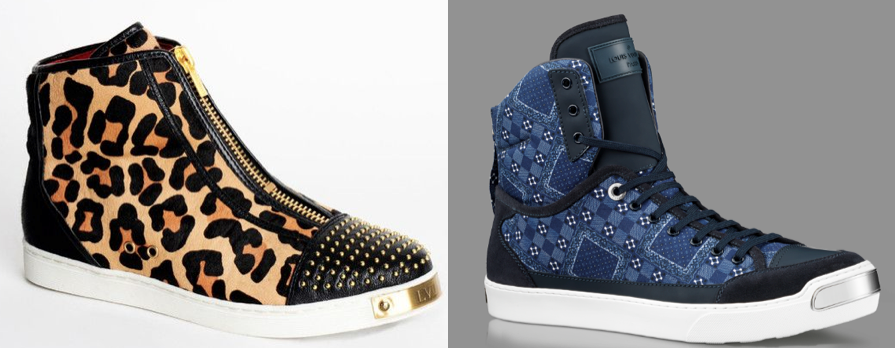
image: Louis Vuitton
After being handed a loss last fall in the case it filed against Louis Vuitton, LVL XIII sought to appeal the court’s decision in March and is slated to go before the Second Circuit court of appeals this week. In its initial complaint, which was filed in July 2014, LVL XIII accused the world’s most valuable luxury brand of selling footwear with an element that is “confusingly similar” to its own – the allegedly “distinctive rectangular metal plate [that adorns] the front of [LVL XIII’s] shoe toe” – and “exploiting the goodwill of LVL XIII in an effort to mislead” consumers and in “a deliberate attempt to divert sales away from LVL XIII.”
LVL XIII, a New York-based footwear brand that got its start in 2012, asserts that its sneakers, which first hit the market in August 2013, with a run of 1,000, include a rectangular toe place design. According to the brand, its footwear has been popular among the likes of Chris Brown, model Tyson Beckford, rappers Nas and Jim Jones, and a handful of pro athletes, thanks, at least, in part, to the brand’s practice of “ceding shoes to celebrities and . . . editors . . . [to] garner interest.”
Louis Vuitton’s allegedly infringing design comes in the form of the “On the Road” sneaker from menswear director Kim Jones’ Spring/Summer 2014 collection for the Paris-based brand.

An LVL XIII shoe (left) & Louis Vuitton’s On the Road sneaker (right)
In September 2016, Judge Paul A. Engelmayer of New York’s Southern District Court dismissed the case in Louis Vuitton’s favor in a rather strongly-worded 107-page decision. In granting Louis Vuitton’s motion for summary judgment – a request for a final decision by a judge that resolves a lawsuit before trial – Engelmayer held that “LVL XIII has not established secondary meaning or a likelihood of confusion,” both of which are essential elements in LVL XIII’s case against Louis Vuitton.
(For the uninitiated, the U.S. Supreme Court held in 2000 that product design trade dress (such as LVL XIII’s toe plate) is never inherently distinctive and so, in order to be eligible for trademark-like protection, the product design must have achieved secondary meaning. “Second meaning” means that a consumer associates the design element at issue with the brand from which it originates. In short: The average must be able to associate the LVL XIII toe plate with the LVL XIII brand in order to it to claim trade dress protection over it).
Judge Engelmayer stated that LVL XIII “has not shown bad faith [on behalf of Louis Vuitton in making its own shoes with toe plates] or a likelihood of confusion [the latter of which is the key inquiry in trademark infringement matters]; and has not shown material deception or public harm,” thereby failing to establish its claims for trademark infringement, unfair competition, and false designation of origin, among others.
In addition to dismissing all of LVL XIII’s claims against its much larger rival, the court also took the opportunity to skewer LVL XIII’s proposed expert testimony, holding that LVL XIII’s expert witness, Charles Colman, who was tasked with determining whether the LVL XIII toe plate had achieved secondary meaning, “supplied virtually no insight into the considerations that shaped his qualitative analysis.” The court stated that Colman “did not preserve, much less produce, the vast majority of the materials on which he purportedly relied. LVL XIII claims that Colman reviewed ‘over 100,000 unsolicited third-party online posts,’ but Colman—astoundingly—produced copies of only 12 posts.”
In sum, Judge Engelmayer held: “The Court holds that Colman’s report and testimony are inadmissible for at least three independent reasons: first, Colman is not qualified to offer the proffered testimony; second, his opinions are unhelpful and unreliable because they do not ‘fit’ the facts of this case; and third, he did not use a reliable methodology. The Court, therefore, grants LV’s motion to preclude Colman’s report and testimony in its entirety.”
It was not a total loss for LVL XIII, however, as the court did dismiss all of Louis Vuitton’s counterclaims against it.
LVL XIII and its founder Antonio Brown appealed the court’s ruling several months later, arguing that the district court erred in dismissing the case and “denying its claims for infringement by Louis Vuitton … of LVL XIII’s brand-wide application of a metallic toe-plate, essentially a label or logo, on a line of exotic men’s “luxury athletic footwear” rapidly adopted by major celebrities and whose popularity was reflected by both social media enthusiasm and actual confusion in the face of Louis Vuitton’s conduct.”
According to LVL XIII’s appeal, “The district court not only misapplied basic tenets of trade dress law but introduced a new, unprecedented and reckless ‘test’ for determining, as an outcome-determinative hard-and-fast rule, whether a configuration of features is entitled to trademark protection: If a configuration is ‘two dimensional,’ the district court held, it is a trademark; and if it is “three dimensional,” it is not. This ‘standard’ was distilled by the district court essentially from thin air, has no basis in law and threatens to undo decades of development of an esoteric but increasingly critical legal doctrine, trade dress law.”
In particular, LVL XIII claims that the court improperly weighed evidence that showed that “by adopting a rectangular metallic toe plate on luxury men’s athletic wear that is confusingly similar to LVL XIII’s Toe Plate—a distinctive brand identifier—Louis Vuitton confused customers and even industry professionals as to the source, sponsorship, affiliation or approval of its [On the Road] Sneaker.”
Such evidence includes text messages, Instagram messages, etc. “from twelve individuals, none of whom was an employee of LVL XIII, who testified that when they encountered the OTR Sneaker they were confused as to whether LVL XIII had collaborated with Louis Vuitton.” (Note: Neither the initial complaint nor the appeal, make mention of the fact that these individuals very may have been confused due to the fact that LVL XIII adopted a brand name that is somewhat similar to that of Louis Vuitton – when abbreviated to LV, as it often is – and to its parent company LVMH).
LVL XIII also claims that “the district court erred in failing to acknowledge that LVL XIII’s proof of extensive social media impact raised at least a question of material fact about LVL XIII Toe Plate’s secondary meaning;” establishing secondary meaning, or that consumers associate the LVL XIII ton plate with the brand, is necessary in order for LVL XIII to make a successful bid for claim trademark infringement.
Still yet, LVL XIII alleges that the court erred in allowing admission of Louis Vuitton’s expert report. According to LVL XIII, Louis Vuitton “played fast and loose with the Rules” in regards to its own expert witness, including “refer[ing] to materials and facts [in his deposition that were] reviewed by him but not disclosed in his report,” providing “evasive responses” in his deposition, and failing “to disclose his review of the Brown transcript before his deposition,” thereby
“prevent[ing] LVL XIII from preparing properly for his deposition”
With all of this in mind, some of the questions before the court on appeal include: Did the district court err in ruling in Louis Vuitton’s favor on the issue of whether LVL XIII’s metallic toe plate is an inherently distinctive product label entitled to trademark protection or on the issue of likelihood of confusion, particularly the similarity of the marks?
Moreover, the LVL XIII has asked the appeals court to consider whether the district court erred in granting summary judgment to Louis Vuitton on the issue of whether the LVL XIII Toe Plate acquired distinctiveness, despite third-party customer testimony concerning actual confusion premised on their recognition of the LVL XIII brand and significant Internet evidence indicating brand recognition including extensive social media recognition?







